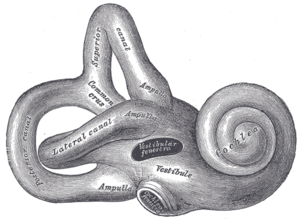迷路炎
| 迷路炎 | |
|---|---|
| 又称 | 内耳炎、前庭神经炎、前庭神经元炎 |
 | |
| 内耳图示 | |
| 患病率 | 每年3500万人感染[1] |
| 分类和外部资源 | |
| 醫學專科 | 耳鼻喉科 |
| ICD-11 | AB30.1 |
| ICD-9-CM | 386.3、386.30 |
| DiseasesDB | 29290 |
| MedlinePlus | 001054 |
| eMedicine | 856215 |
迷路炎(英文:Labyrinthitis),又称内耳炎(Otitis interna),是指内耳的炎症,即内耳迷路(骨迷路、膜迷路)受到感染發炎[2][3]。迷路炎影响内耳迷路的耳蜗和前庭系统,常由病毒感染导致,可造成长时间的眩晕、恶心、耳鸣甚至听觉障碍[2][3][4]。极少数情况可造成永久性听觉丧失[5]。
迷路炎与前庭神经炎(英文:Vestibular neuritis;又称前庭神经元炎,Vestibular neuronitis)联系密切,有时混称,但后者实际指前庭神经发炎,可造成长时间眩晕而无严重听力损失[2][6][7]。前庭神经为前庭耳蜗神经的一个分支,与人体的平衡觉相关[8]。
致病机制
[编辑]迷路炎与前庭神经炎致病机制不完全明确。迷路炎可进一步分为浆液性和化脓性两类[4][9]:
- 浆液性迷路炎即病毒性迷路炎(较常见),由内耳迷路的病毒感染所致,听力损失和眩晕的程度较化脓性为轻,听力损失通常可以恢复。
- 化脓性迷路炎即细菌性迷路炎(较少见),由细菌直接感染内耳所致,继发于中耳炎或脑膜炎,通常表现为重度到极重度听力下降和眩晕。
此外,迷路炎与前庭神经炎的出现也可由于脑部受伤、极度压力、过敏或是药物影响。部分患者在发病前得过普通感冒(约30%[1])或流感[9]。也有疱疹病毒感染的病例[2]。乘飞机和水肺潜水时,周围环境压力突变也可造成该病发作[10][11][12]。
该病发生率约每10万人口中有3.5例,大部分年龄为30-60岁,主要为40-50岁,但无明显性别差异[1]。
症状
[编辑]迷路炎与前庭神经炎均起病急,一次发作持续数分钟至数小时,可出现眩晕、失衡、耳鸣、耳内膨胀感/阻塞感、恶心、呕吐、视觉跳跃(由于眼部不受控运动/眼球震颤)[2][3][13][14]。迷路炎一般在几天内结束,但部分持续症状可能持续数周或数月才完全消退[7][13]。
诊断
[编辑]依据病史,进行体格检查、听力学检查、眼震电图检测或核磁共振成像(MRI)[4][9][13]。诊断时要排除其它可导致眩晕的疾病,譬如良性阵发性姿势性眩晕、梅尼埃病[15]。还有一些更严重的疾病与迷路炎有相同的临床特征,尤其是中枢神经系统的急性血管病变,因此必须准确区分,以避免并发症和死亡[6]。
治疗
[编辑]迷路炎与前庭神经炎一般可自行恢复[2][9]。较严重的患者可服用前庭抑制剂、止吐药或其它抑制眩晕的药物,比如美克洛嗪、劳拉西泮、Prochlorperazine等[4][13]。由于大多数感染为病毒性,故抗生素治疗可能无效[9]。
参见
[编辑]参考资料
[编辑]- ^ 1.0 1.1 1.2 Greco, A; Macri, GF; Gallo, A; Fusconi, M; De Virgilio, A; Pagliuca, G; Marinelli, C; de Vincentiis, M. Is vestibular neuritis an immune related vestibular neuropathy inducing vertigo?. Journal of Immunology Research. 2014, 2014: 459048. PMC 3987789
 . PMID 24741601. doi:10.1155/2014/459048.
. PMID 24741601. doi:10.1155/2014/459048.
- ^ 2.0 2.1 2.2 2.3 2.4 2.5 Labyrinthitis and Vestibular Neuritis. 约翰霍普金斯大学. [2021-02-28]. (原始内容存档于2021-02-27) (英语).
- ^ 3.0 3.1 3.2 Barkwill, David; Arora, Rubeena. Labyrinthitis. StatPearls. Treasure Island (FL): StatPearls Publishing. 2021. PMID 32809341.
- ^ 4.0 4.1 4.2 4.3 迷路炎 - 症状、诊断和治疗 | BMJ Best Practice. 英国医学杂志(BMJ). [2021-02-28]. (原始内容存档于2020-12-06) (中文).
- ^ Labyrinthitis. Cedars-Sinai. [2021-02-28]. (原始内容存档于2020-11-20) (美国英语).
- ^ 6.0 6.1 前庭神经炎和迷路炎. www.uptodate.com. [2021-02-28] (中文).
- ^ 7.0 7.1 Smith, Travis; Rider, Justin; Cen, Steven; Borger, Judith. Vestibular Neuronitis. StatPearls. Treasure Island (FL): StatPearls Publishing. 2021 [2021-02-28]. PMID 31751056. (原始内容存档于2020-12-08).
- ^ Information, National Center for Biotechnology; Pike, U. S. National Library of Medicine 8600 Rockville; MD, Bethesda; Usa, 20894. How does our sense of balance work?. Institute for Quality and Efficiency in Health Care (IQWiG). 2017-09-07 [2021-02-28]. (原始内容存档于2022-01-16) (英语).
- ^ 9.0 9.1 9.2 9.3 9.4 Labyrinthitis and Vestibular Neuritis. CS Mott Children's Hospital. [2021-02-28]. (原始内容存档于2021-11-19) (英语).
- ^ Martin-Saint-Laurent A, Lavernhe J, Casano G, Simkoff A. Clinical aspects of inflight incapacitations in commercial aviation. Aviation, Space, and Environmental Medicine. March 1990, 61 (3): 256–60. PMID 2317181.
- ^ Farmer, Jr JC (编). Labyrinthine Dysfunction During Diving. 1st Undersea and Hyperbaric Medical Society Workshop. UHMS Publication Number WS6-15-74. Undersea and Hyperbaric Medical Society: 11. 1973 [2009-03-11]. (原始内容存档于2009-07-03).
- ^ Kennedy RS. General history of vestibular disorders in diving. Undersea Biomedical Research. March 1974, 1 (1): 73–81 [2009-03-11]. PMID 4619861. (原始内容存档于2010-06-15).
- ^ 13.0 13.1 13.2 13.3 Vestibular Neuronitis - Ear, Nose, and Throat Disorders. Merck Manuals Consumer Version. [2021-02-28]. (原始内容存档于2021-04-30) (美国英语).
- ^ Inner Ear Infection (Labyrinthitis) Symptoms, Causes, Contagious, Treatment Cure. MedicineNet. [2021-03-01]. (原始内容存档于2021-04-17) (英语).
- ^ Types of Vestibular Disorders. VeDA. [2021-02-28]. (原始内容存档于2021-05-06) (美国英语).
